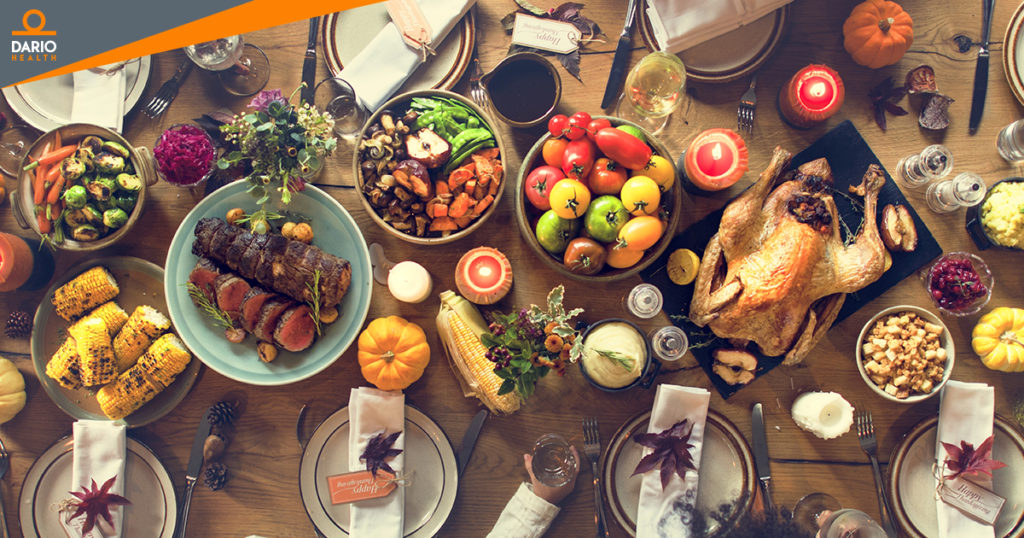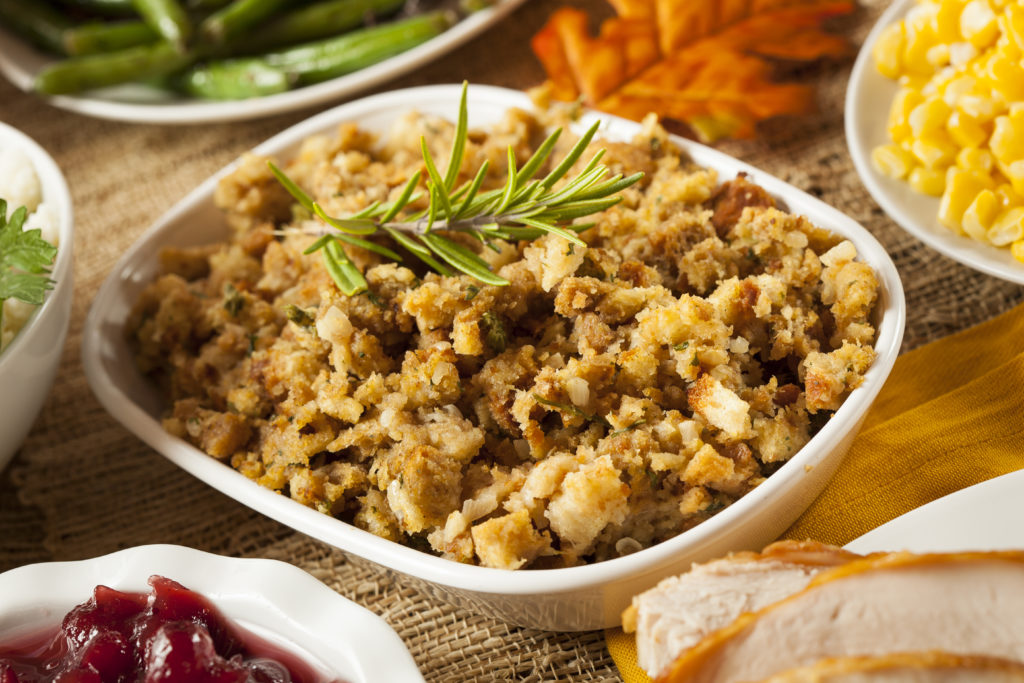Mindful Eating for Thanksgiving
This is how to enjoy Thanksgiving Day without sacrificing the scrumptious meal.

By Susan B. Sloane, BS, RPh, CDE
The first of the big winter holidays is upon us. Thanksgiving is a festive Holiday centered around family and friends – and of course, food.
Food can be a source of stress for those of us affected by diabetes. During the holidays we seem to be surrounded by delicacies we can’t touch – or can we?
A lot of people living with diabetes have noted that the holidays can be a stressful time because of the way food is deeply incorporated into all of the winter holidays. Raising two sons with diabetes has taught me how to overcome the fear of the holidays and how to more mindfully handle the food element of Thanksgiving.
Mindful eating: it sounds like an interesting concept, but what does it even mean?
We live in such a fast-paced world that we often perform tasks without even thinking about them. Think about driving a car; how many times have you driven somewhere without remembering the drive at all? You probably felt like you were on autopilot, and in some ways you probably were.
If you were to take a moment to train your mind and pay attention to your surroundings, you would begin to notice things that you would have otherwise ignored: the color of the changing leaves, the new restaurant that popped up next door, the construction that’s being done near your local mall.
The same is true of eating. If you don’t eat mindfully, that is, by paying attention to what you eat and the quantity you consume, you may just continue eating things that aren’t healthy or foods that increase your blood glucose levels.
When I was writing this article, I got hungry and automatically reached for a bag of leftover Halloween candy I had sitting on the desk. I suddenly realized what I was doing and I stopped. I told myself that there were healthier options in my refrigerator, only a few steps away, got up and took out a salmon burger. At that very moment, I became mindful of my food options and picked the option that was best for my health.
This may sound trivial, but the truth is it takes a fair amount of training and preparation to make sure you have healthy options at your disposal all the time. If you don’t have a more healthful option ready in the fridge, then you’ll never make the switch to healthier foods. If you take the initiative to prepare healthy foods in advance, you can make mindful eating choices easier.
In terms of your Thanksgiving meal, there are some mindful food choices you can make that will help you control your blood glucose levels.
There will most likely be a turkey, ham, or some other “central” piece of meat or fish served at your Thanksgiving meal. These are good sources of protein and don’t raise blood sugars a lot, but it’s the side courses that will most likely pose problems for those living with diabetes.
There are some traditional side dishes that are served at nearly every Thanksgiving dinner. These side dishes are extremely tasty, but they can be the most dangerous for people living with diabetes. In order to make the meal as healthy and satisfying as possible without giving up on those traditional side dishes, try these options.
Classic Mashed Potatoes
Everybody loves this as a side dish: creamy mashed potatoes with gobs of butter. But white potatoes can cause extreme increases in blood glucose. Instead, try using mashed cauliflower which also has a significant amount of fiber and is much lower in calories.
You can also use whole grain rice or try barley, which is a grain that has a very minimal effect on blood sugars.
Another form of rice that is often forgotten is black rice. Black rice has been touted as a superfood; it comes from Southeast Asia, and is very high in nutrient value and does not cause heavy glucose spikes.
If you still want to include the potato in your side dish you can scoop out a baked potato and fill it with veggies. Similarly, you can consider adding vegetables and some slivered almonds to your mashed potatoes. This addition of fiber-rich foods to the potatoes will help blunt any spikes in blood sugars.

Smooth and Creamy Thanksgiving Gravy
I love gravy and when I was younger, I used to add gravy to my meal to the point where my plate looked like a bowl of soup! Portion control is key when gravy is involved. Remember with portion control, less is more.
One suggestion is to try adding fresh cranberries mixed with the gravy. The cranberries give extra flavor and supply their own juice, allowing you to use less gravy without giving up the taste.
When possible, I recommend you make gravy from scratch. Canned gravy has a lot of additives and salt, and can also be high in fat. Anyway, homemade gravy is so much yummier!
Savory Stuffing
Who doesn’t love stuffing? You can make stuffing healthier by adding things that aren’t bread. Remember the black rice and barley we spoke about earlier? These make great additions to stuffing.
By using less bread and more healthy vegetables you can cut the amount of carbs in your stuffing but you can still have flavor. One of my favorite substitutes is adding artichokes and chia seeds. Not only is the combination delicious, it also adds more fiber and protein to the meal – both positives to help keep your blood glucose under control!

Desserts
Dessert has always been my favorite part of the meal, but it’s also the most difficult for someone living with diabetes. While I generally advocate for enjoying all things in moderation, there are actually some healthy and sweet dessert options that will fill you up.
Fresh fruit is, of course, one of the simplest and healthiest alternatives for dessert. Blackberries and raspberries are fabulous fruit options this time of year and make for a great decoration on the Thanksgiving table. You should try to avoid a lot of dried fruit, as they are high in sugar content.
If you’re preparing your own desserts, there are some simple ways to remove sugars by replacing them with other ingredients that can act as sweeteners. For example, I often use applesauce as a replacement to added sugars in desserts.
A great dessert option is these extremely popular diabetes-friendly chocolate chip cookies. Give them a shot! Your guests might not even guess they’re eating a diabetes-friendly dessert.

One of the best tips is not to come to a Thanksgiving meal super hungry. Often, people don’t eat all day in anticipation for the big meal; if you’re living with diabetes, this is a bad strategy because you’re likely to binge and lose control of the portions you are trying to control.
I recommend eating a protein snack a few hours before the holiday feast so that you don’t overindulge. Also, during your Thanksgiving meal, try eating the protein first; it will fill you up faster and help you refrain from overeating.
Thanksgiving is a great time of the year and a fabulous way to spend time with the family. The tips above are some simple suggestions on how you can live a healthy holiday.
Just remember, extreme change is difficult to implement and even harder to stick with. If you have a favorite dish, don’t try and give it up. Instead, focus on moderation and only consuming reasonable portions.
My biggest piece of advice is not only to be mindful of what you’re eating but also be mindful of the loved ones that surround you and what you are grateful for. Enjoy and Happy Thanksgiving!
About Susan Sloane
Susan B. Sloane, BS, RPh, CDE, has been a registered pharmacist for more than 29 years and a Certified Diabetes Educator for most of her career. Her two sons were diagnosed with diabetes, and since then, she has been dedicated to promoting wellness and optimal outcomes as a patient advocate, information expert, educator, and corporate partner.
Susan has published numerous articles on the topic of diabetes for patients and health care professionals. She has committed her career goals to helping patients with diabetes stay well through education.
<b>Medical Disclaimer</b>
The articles provided on this website are for informational purposes only. In addition, it is written for a generic audience and not a specific case; therefore, this information should not be used for diagnostic or medical treatment. This site does not attempt to replace the patient-physician relationship and fully recommends the reader to seek out the best care from his/her physician and/or diabetes educator.
DAR -0095 RevA 06/2019







